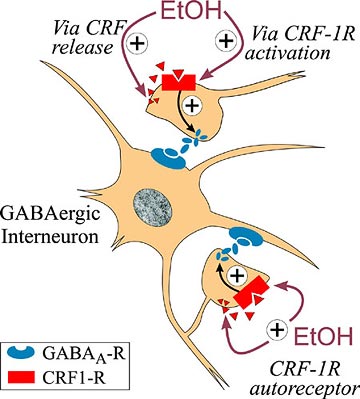
Top synapse: Because these interneurons can contain both the inhibitory transmitter GABA (blue spheroids) and the neuropeptide CRF (red triangles), ethanol could enhance the release of GABA from a classical terminal of another GABAergic interneuron, either via: 1) the release from the same terminal of CRF, that then feeds back to act on CRF-R1 receptors on the terminal to elicit (black arrow) release of more GABA, or; 2) direct activation CRF-R1 receptors to evoke the release of more GABA.
Bottom synapse: A synapse could feed back onto the same neuron to act on GABAergic "autoreceptors" on its dendrites. Ethanol then may enhance GABA release onto these GABA receptors via CRF release or via CRF-1R receptor activation, as in the top synapse. Thus, ethanol may augment the "autoinhibition" of this inhibitory interneuron, leading to excitation of downstream neurons by "disinhibition." Illustration by Paul Schweitzer.